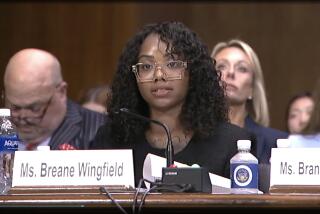Abuse Knows No Gender, Says Men’s Shelter Founder : Although few men are battered, Minnesotan contends the center fills a need. Questions are raised about his background, motives.
ST. PAUL, Minn. — Calling himself a defender of the invisible victims of domestic abuse, a Minnesota man with a mission--and an assault record--has opened what may be the first battered men’s shelter in the United States.
George Gilliland Sr. and a group of volunteers are busy painting, carpeting and furnishing the Men’s Shelter of Minnesota in a Victorian house in the city’s working-class East Side. Operating on donations and a sliding fee scale, by month’s end they expect to have readied seven bedrooms for battered men and their children.
Gilliland understands that some people may have a hard time imagining a man fleeing to a shelter.
“The unfortunate part is that rather than concentrate on all victims of abuse, the thrust of (public) attention is all slanted toward women and battered women,” he said.
Gilliland, 53, says that not only are men victims of domestic violence, but they are also more frequently on the receiving end of physical assault than are women.
He insists that that’s what happened to him.
“I was innocent of assault and domestic abuse,” he said. “Thousands of guys go to jail every year who are innocent of domestic abuse.”
That denial rankles his opponents.
Gilliland said he often gets calls from men complaining of broken noses and slash wounds that they say were inflicted by wives and girlfriends. Many are too ashamed to speak out or get help, fearing ridicule and loss of home and children, he said.
Blaine McCutchan, a volunteer working at the house one recent weekend, said he lost everything after an 18-year marriage went bad. Arguments over religion escalated to the point where he was kicked down the stairs, he said.
McCutchan said he lost his kids, his house and later his job because of depression.
In 1988 Gilliland formed the Domestic Rights Coalition, a men’s rights, referral and support organization that has made many enemies among women’s rights advocates.
Gilliland said he knows firsthand how the system is stacked against men. In a 1988 incident, he said, he called police to de-escalate an argument with his now ex-wife. When he was arrested, Gilliland claims, his attorney advised him to plead guilty to misdemeanor assault and he spent a month in jail. He maintains he was not guilty.
“One time she took a small board with a nail in it and hit me in the forehead,” Gilliland said, adding that the nail barely missed him.
He claims he was tossed out of their home and had to live in the back of his station wagon with his dogs for three days. “A shelter like this would have been ideal.”
Gilliland has so infuriated some women’s advocates that a spokeswoman from the Minnesota Coalition for Battered Women refused to be interviewed for an article unless it portrayed Gilliland as a “charlatan.” Some women’s rights’ supporters see Gilliland as someone who stands up for abusers in court.
Gilliland acknowledges his troubled past. “Back in my drinking years, I got in fights in bars. But I’ve been sober 18 years and I have had no problems.” In addition to the 1988 domestic abuse incident, Gilliland’s girlfriend in 1992 obtained a protection order against him, which she later withdrew. He also was found guilty that year of disorderly conduct in an incident at St. Paul’s Ramsey County family court building.
But Gilliland’s message has persuaded dozens of companies to donate furniture, food, lumber, labor, used appliances and toiletries to the home. The shelter has drawn an estimated $7,000 in cash donations and $15,000 in furnishings and other goods.
An expert on family violence says research is often misunderstood or misrepresented. “Women are about as likely to hit men in a relationship as vice versa . . . but the most accurate measure is who gets hurt,” said Richard Gelles, a professor at the University of Rhode Island and director of the Family Violence Research Program.
For every five men hurt by women, 95 women are injured by men, he said. In addition, the numbers must be put into the context of a slap versus a punch, and patterns of behavior over time, which overwhelmingly show men as perpetrators of violence, Gelles added.
Gelles said he has never heard of another battered men’s shelter in the country and predicts that it will be used more as a place to cool off and a center for resources and referrals than as a traditional shelter.
As of Jan. 1, the Men’s Shelter of Minnesota had accommodated three men overnight, but they didn’t enter the door injured. Gilliland said they were dropped voluntarily at the shelter by the St. Paul police, who had responded to domestic calls but didn’t make arrests.
That doesn’t bother Gilliland, who sees the house offering various services. If the shelter can help defuse potentially violent situations, then it’s performing an important service, Gilliland said.
Gilliland says he wants to work with the police, courts and therapists to help domestic abuse victims. “I think it’s important to acknowledge the fact that there are thousands of battered women, but let’s not let that overshadow the fact that many thousands of battered men also need help,” he said.
Some who work in the field agree that the system needs to break through stereotypes.
Mary Griffith, who coordinates volunteers in the Hennepin County domestic abuse office in Minneapolis, said advocates for men and women must learn to work together to stop the cycle of domestic abuse.
More to Read
Sign up for Essential California
The most important California stories and recommendations in your inbox every morning.
You may occasionally receive promotional content from the Los Angeles Times.










